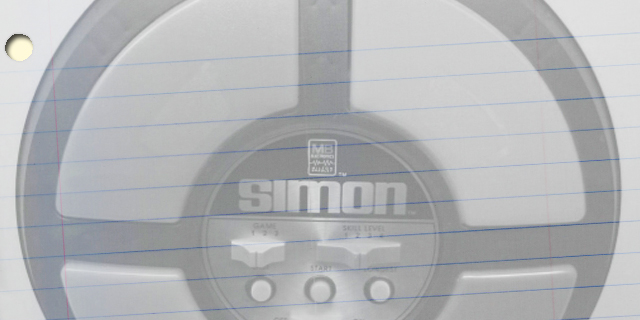
Genre 101 is a series that looks at the past and present of a game genre to find lessons about what defines it. In this installment, Eric Albuen explains the ins and outs of rhythm games.
Repeat after me
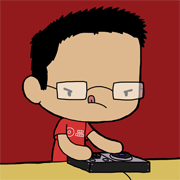 Eric Albuen: While not necessarily a music game itself, Simon was one of the first games widely available to the public that introduced musical elements to assist in the gameplay. The player would have to play a sequence that the game provides for you. Along with the flashing lights to assist you, the game had subtle tones for each color. Whether players knew it or not, they were repeating back a set of notes in harmony no matter which order they played them in.
Eric Albuen: While not necessarily a music game itself, Simon was one of the first games widely available to the public that introduced musical elements to assist in the gameplay. The player would have to play a sequence that the game provides for you. Along with the flashing lights to assist you, the game had subtle tones for each color. Whether players knew it or not, they were repeating back a set of notes in harmony no matter which order they played them in.
 Graham Russell: It’s no coincidence that Simon was also invented, in part, by Ralph Baer, the creator of the Brown Box and one of the industry’s founding fathers. The ideas behind rhythm games come from this incredibly basic idea, making rhythm as much of a core game genre as sports. This isn’t an abstract concept like platformers or RPGs; it’s a direct translation of real life.
Graham Russell: It’s no coincidence that Simon was also invented, in part, by Ralph Baer, the creator of the Brown Box and one of the industry’s founding fathers. The ideas behind rhythm games come from this incredibly basic idea, making rhythm as much of a core game genre as sports. This isn’t an abstract concept like platformers or RPGs; it’s a direct translation of real life.
 Music and rhythm happen all around us, whether we’re aware of it or not. Doing things by memory and recognizing patterns is something that comes natural to us as humans, and it’s obvious to see why this simple concept worked in music games. We also saw this very concept being used in Space Channel 5. The enemy would present a rhythmic pattern, and the player would have to play it back to save civilians from being taken over by funky aliens.
Music and rhythm happen all around us, whether we’re aware of it or not. Doing things by memory and recognizing patterns is something that comes natural to us as humans, and it’s obvious to see why this simple concept worked in music games. We also saw this very concept being used in Space Channel 5. The enemy would present a rhythmic pattern, and the player would have to play it back to save civilians from being taken over by funky aliens.
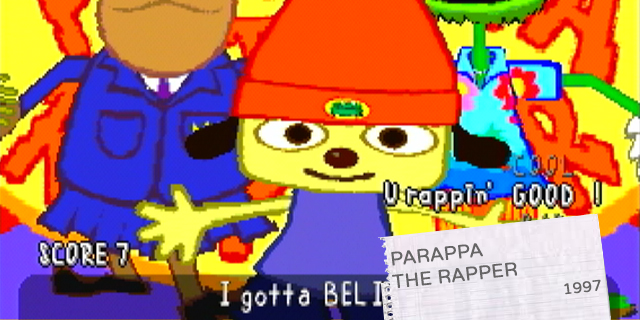
Believing in yourself
 While many rhythm games have forced players to play directly to the music, PaRappa the Rapper did something different. Like how rappers don’t always follow a set of lyrics, the game encouraged you to freestyle and bring your creativity into the game. Doing so would bring your score up and get a better rating on the game’s stages. Parappa is often regarded as one of the pioneers of modern rhythm gaming. At the time it was something different and fresh.
While many rhythm games have forced players to play directly to the music, PaRappa the Rapper did something different. Like how rappers don’t always follow a set of lyrics, the game encouraged you to freestyle and bring your creativity into the game. Doing so would bring your score up and get a better rating on the game’s stages. Parappa is often regarded as one of the pioneers of modern rhythm gaming. At the time it was something different and fresh.
 And it took something like PaRappa to make the rhythm genre a reality. We just discussed how fundamental it is, but it wasn’t showing up in any tangible way. PaRappa was much closer to the ‘90s definition of a game than anything that followed, but it had to be; it was treading new ground. It spawned its own line of story-based rhythm releases, but its most important role was as a gateway.
And it took something like PaRappa to make the rhythm genre a reality. We just discussed how fundamental it is, but it wasn’t showing up in any tangible way. PaRappa was much closer to the ‘90s definition of a game than anything that followed, but it had to be; it was treading new ground. It spawned its own line of story-based rhythm releases, but its most important role was as a gateway.
 One of the biggest things about the rhythm genre was how taking chances became the norm. The game took a lot of chances with the quirky graphical style and the goofy music in-game soundtrack. The simple gameplay helped a lot too. The game said that it was okay to be different, to have your own style.
One of the biggest things about the rhythm genre was how taking chances became the norm. The game took a lot of chances with the quirky graphical style and the goofy music in-game soundtrack. The simple gameplay helped a lot too. The game said that it was okay to be different, to have your own style.
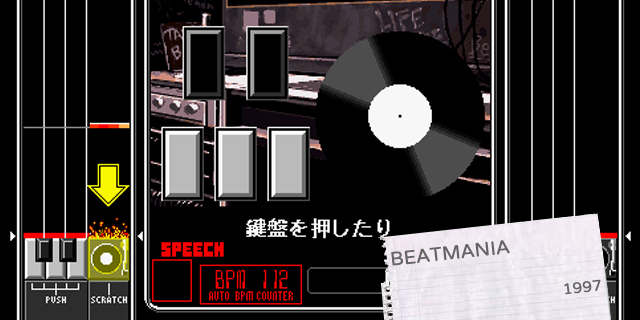
Keep the beat or you’re beaten
 Beatmania, created by Konami in 1997, started the era of modern arcade rhythm gaming. It was a DJ simulator; you had a turntable and five piano keys to play back a sequence of notes on screen. Much like how a DJ creates and mixes music, each note the player played had a specific sound. Play all the notes in sequence, and you essentially create music. From 1997 to 2002, 13 arcade games were released, adding new music and refining the gameplay. The game saw brief releases releases in both Korea, under the name BeatStage, and North America, under the name HipHopMania.
Beatmania, created by Konami in 1997, started the era of modern arcade rhythm gaming. It was a DJ simulator; you had a turntable and five piano keys to play back a sequence of notes on screen. Much like how a DJ creates and mixes music, each note the player played had a specific sound. Play all the notes in sequence, and you essentially create music. From 1997 to 2002, 13 arcade games were released, adding new music and refining the gameplay. The game saw brief releases releases in both Korea, under the name BeatStage, and North America, under the name HipHopMania.
 It’s here that music games were really codified into the basic “indicators moving toward a target” formula. Much like songs have sheet music, these games give you a way to sight-read the upcoming passages and jog your memory about what comes next. (Beatmania also introduced a brutal difficulty into the genre, and the hyper-competitive community that came with it.)
It’s here that music games were really codified into the basic “indicators moving toward a target” formula. Much like songs have sheet music, these games give you a way to sight-read the upcoming passages and jog your memory about what comes next. (Beatmania also introduced a brutal difficulty into the genre, and the hyper-competitive community that came with it.)
 The arcade setting was perfect for Beatmania and many other Bemani titles. The social setting was great for making new friends and rivals, and these games sped up the process, allowing players to find common ground simply by just playing the game. The game lives on today through Beatmania IIDX, and is currently in its 20th installment. The brutal difficulty that was forged in the original game is still found today, pushing players to their limits.
The arcade setting was perfect for Beatmania and many other Bemani titles. The social setting was great for making new friends and rivals, and these games sped up the process, allowing players to find common ground simply by just playing the game. The game lives on today through Beatmania IIDX, and is currently in its 20th installment. The brutal difficulty that was forged in the original game is still found today, pushing players to their limits.
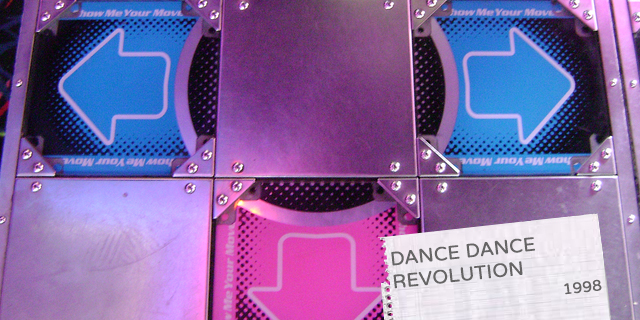
Next steps to popularity
 In 1998, Konami released Dance Dance Revolution, a game like no one had ever seen before. A game that made you use your feet to follow sequential patterns on a four-panel dance pad to loud club music. Never before had playing a game really been beneficial. For years, the series had generated great public support, and even found its way into schools for gym activities.
In 1998, Konami released Dance Dance Revolution, a game like no one had ever seen before. A game that made you use your feet to follow sequential patterns on a four-panel dance pad to loud club music. Never before had playing a game really been beneficial. For years, the series had generated great public support, and even found its way into schools for gym activities.
 It did all this by being noticed. Dance Dance Revolution is a spectacle of the highest order, and never before would an arcade game gather so much attention from passers-by. Modern rhythm games do that regularly; it’s genuinely fun to watch people play them. But would we have gotten here if it weren’t for DDR and its massive, arrow-laden cabinets?
It did all this by being noticed. Dance Dance Revolution is a spectacle of the highest order, and never before would an arcade game gather so much attention from passers-by. Modern rhythm games do that regularly; it’s genuinely fun to watch people play them. But would we have gotten here if it weren’t for DDR and its massive, arrow-laden cabinets?
 Definitely not. While Beatmania had forged the path for rhythm games in Japan, DDR opened up the genre for many in North America, mainly because they were much more common. It was typical to see the game at a theme park, recreation center or mall arcade throughout the 2000s. Due to its exposure in public places, it made it an easy sell for those who wanted to play the game and get better in the privacy of their own homes.
Definitely not. While Beatmania had forged the path for rhythm games in Japan, DDR opened up the genre for many in North America, mainly because they were much more common. It was typical to see the game at a theme park, recreation center or mall arcade throughout the 2000s. Due to its exposure in public places, it made it an easy sell for those who wanted to play the game and get better in the privacy of their own homes.
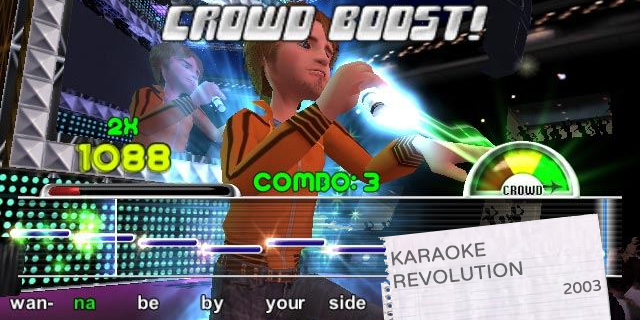
Finding a new voice
 An early Harmonix release, the game took a popular party activity turned it into a test of skill. The game sold well, due to its mainstream song list and easy-to-pick-up gameplay: all you had to do was sing into the microphone. As the titles developed, the game eventually picked up big names like American Idol and Glee, further solidifying the popularity of the series.
An early Harmonix release, the game took a popular party activity turned it into a test of skill. The game sold well, due to its mainstream song list and easy-to-pick-up gameplay: all you had to do was sing into the microphone. As the titles developed, the game eventually picked up big names like American Idol and Glee, further solidifying the popularity of the series.
 It may not have been obvious at its inception, but Karaoke Revolution may be the best indicator for where rhythm games are going in the post-Guitar Hero era. Titles like Rocksmith and Dance Central strive to translate real-life skill into the game instead of simple button presses, and Karaoke Revolution could do that with singing a decade ago. The franchise itself may have lost its way, distracting itself with various licensing deals, but its ideas live on.
It may not have been obvious at its inception, but Karaoke Revolution may be the best indicator for where rhythm games are going in the post-Guitar Hero era. Titles like Rocksmith and Dance Central strive to translate real-life skill into the game instead of simple button presses, and Karaoke Revolution could do that with singing a decade ago. The franchise itself may have lost its way, distracting itself with various licensing deals, but its ideas live on.
 Karaoke Revolution definitely made strides, with songs many people knew. What the game did was finally add a scoring system that players could use for a sing-off against their friends. Because of the game’s proper pitch recognition and compensation for different voice ranges, Harmonix gave karaoke a competitive environment.
Karaoke Revolution definitely made strides, with songs many people knew. What the game did was finally add a scoring system that players could use for a sing-off against their friends. Because of the game’s proper pitch recognition and compensation for different voice ranges, Harmonix gave karaoke a competitive environment.
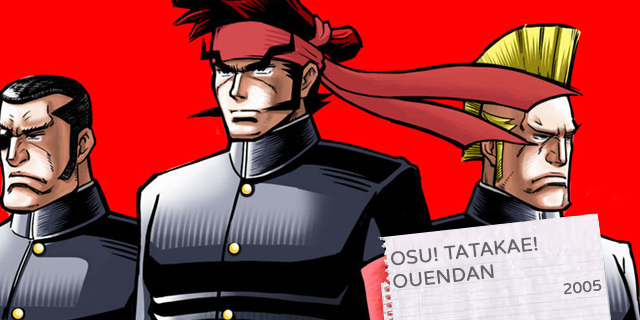
Tapping into a new demographic
 The Nintendo DS wasn’t an obvious place to expect a rhythm game, but one that also featured an all-male cheer squad cheering people on in everyday situations? Oddly enough, it did happen. Japanese developer iNiS produced Osu! Tatakae! Ouendan, letting players tap and drag notes to popular Japanese tracks.
The Nintendo DS wasn’t an obvious place to expect a rhythm game, but one that also featured an all-male cheer squad cheering people on in everyday situations? Oddly enough, it did happen. Japanese developer iNiS produced Osu! Tatakae! Ouendan, letting players tap and drag notes to popular Japanese tracks.
 Touch screens and headphones. Modern handhelds and smartphones have been kind to rhythm games, possibly because people are already listening to music on the go. When you’re commuting or just waiting around, why not make a game of it? And while Ouendan (and English release Elite Beat Agents) didn’t have the song selection to fit into that mold very well, the mechanics here have definitely stuck around.
Touch screens and headphones. Modern handhelds and smartphones have been kind to rhythm games, possibly because people are already listening to music on the go. When you’re commuting or just waiting around, why not make a game of it? And while Ouendan (and English release Elite Beat Agents) didn’t have the song selection to fit into that mold very well, the mechanics here have definitely stuck around.
 The game’s animation style helped a lot with the game’s appeal, and made it a pleasure to watch the situations these distressed people get into.
The game’s animation style helped a lot with the game’s appeal, and made it a pleasure to watch the situations these distressed people get into.
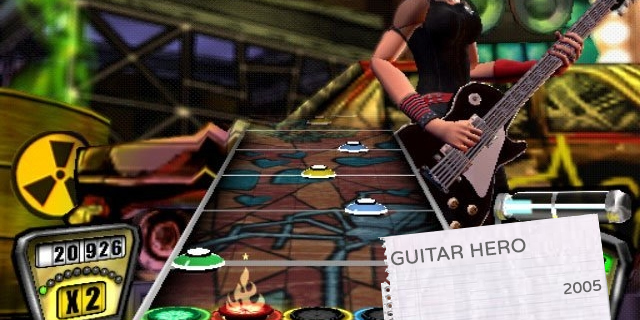
The breakthrough hit
 Guitar Hero was not actually the first guitar video game to be released to the public; that honor actually goes to Konami’s GuitarFreaks. But the thing that Harmonix did right? Filling its songlist with mainstream music people knew. It catered to both casual and hardcore players alike, with ranging difficulties that allowed players to ease into songs with the hit-or-miss rating system.
Guitar Hero was not actually the first guitar video game to be released to the public; that honor actually goes to Konami’s GuitarFreaks. But the thing that Harmonix did right? Filling its songlist with mainstream music people knew. It catered to both casual and hardcore players alike, with ranging difficulties that allowed players to ease into songs with the hit-or-miss rating system.
 Right! This was crucial. Like it or not, music games rely heavily on players knowing the music, and with most games before Guitar Hero, that meant you had to play and fail a few times before you really had a chance. Lowering this barrier meant that it could find a place as a party fixture, and having songs normal people actually wanted to hear didn’t hurt either.
Right! This was crucial. Like it or not, music games rely heavily on players knowing the music, and with most games before Guitar Hero, that meant you had to play and fail a few times before you really had a chance. Lowering this barrier meant that it could find a place as a party fixture, and having songs normal people actually wanted to hear didn’t hurt either.
 At the time, Harmonix didn’t realize how big this game would be. The game’s popularity would spark a plastic peripheral push, flooding homes with inconveniently-shaped controllers. Another bonus to this success? The boost it gave to featured indie artists. The game’s overwhelming popularity helped put them on the map as artists.
At the time, Harmonix didn’t realize how big this game would be. The game’s popularity would spark a plastic peripheral push, flooding homes with inconveniently-shaped controllers. Another bonus to this success? The boost it gave to featured indie artists. The game’s overwhelming popularity helped put them on the map as artists.
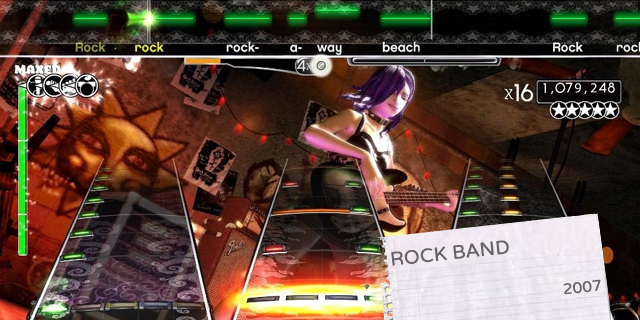
Banding together
 Rock Band was a fusion of two successful formulas. With the addition of the the easy-to-play drum set and eventual harmonies on vocals, the game was a huge success. A lot of its replayability came from being able to transfer each game’s huge library of songs into the following game ,and with over 1000 songs available through DLC, players found no shortage to what fit their tastes.
Rock Band was a fusion of two successful formulas. With the addition of the the easy-to-play drum set and eventual harmonies on vocals, the game was a huge success. A lot of its replayability came from being able to transfer each game’s huge library of songs into the following game ,and with over 1000 songs available through DLC, players found no shortage to what fit their tastes.
 While Guitar Hero was the breakthrough hit, Rock Band was the one to truly find success as a platform. Sure, there were games with DLC before it, but it wasn’t like it is now. Generally, the idea was that you’d buy a disc and enjoy the songs on it. But music is very much about taste, and it wasn’t necessary to come up with whole new game innovations to justify giving players more songs. Now, rhythm games feel inadequate without a steady stream of weekly song releases.
While Guitar Hero was the breakthrough hit, Rock Band was the one to truly find success as a platform. Sure, there were games with DLC before it, but it wasn’t like it is now. Generally, the idea was that you’d buy a disc and enjoy the songs on it. But music is very much about taste, and it wasn’t necessary to come up with whole new game innovations to justify giving players more songs. Now, rhythm games feel inadequate without a steady stream of weekly song releases.
 Rock Band definitely spoiled the masses, but it worked out great for Harmonix. Learning from Karaoke Revolution and Guitar Hero, it realized it didn’t have to continuously release new game after new game to satisfy people. Players just want content and developer support, and Harmonix happily provided that to its fanbase. While the Rock Band series only had three installments, it managed to provide a game experience much deeper than Guitar Hero or Karaoke Revolution could do on their own. With the addition of drums and a keyboard later on, it provided both the quintessential party experience and a challenging single-player one.
Rock Band definitely spoiled the masses, but it worked out great for Harmonix. Learning from Karaoke Revolution and Guitar Hero, it realized it didn’t have to continuously release new game after new game to satisfy people. Players just want content and developer support, and Harmonix happily provided that to its fanbase. While the Rock Band series only had three installments, it managed to provide a game experience much deeper than Guitar Hero or Karaoke Revolution could do on their own. With the addition of drums and a keyboard later on, it provided both the quintessential party experience and a challenging single-player one.
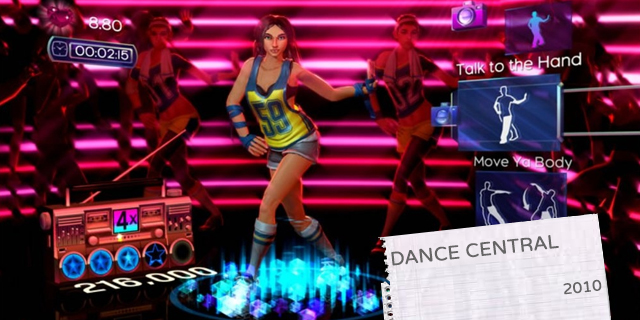
New plans put in motion
 While Just Dance pulled the trigger first, Dance Central stepped strongly into the scene with the release of the Kinect. With hundreds of different dance moves set to popular music, it was an extremely easy sell to show off exactly what the brand new Microsoft device could do. What made this game shine were the complex choreography and in-depth modes that would allow players to learn moves step-by-step.
While Just Dance pulled the trigger first, Dance Central stepped strongly into the scene with the release of the Kinect. With hundreds of different dance moves set to popular music, it was an extremely easy sell to show off exactly what the brand new Microsoft device could do. What made this game shine were the complex choreography and in-depth modes that would allow players to learn moves step-by-step.
 So we’ve come full circle. With the advent of full-body motion control, rhythm games are once again a core, natural, obvious pillar. They’re replicating real-life skills. They have constant DLC song releases, they’re an absolute showpiece for spectators and they encourage creativity within constraints. And yet they’re still, at their core, about pattern memorization. If we’re learning about rhythm games, Dance Central is a crash course.
So we’ve come full circle. With the advent of full-body motion control, rhythm games are once again a core, natural, obvious pillar. They’re replicating real-life skills. They have constant DLC song releases, they’re an absolute showpiece for spectators and they encourage creativity within constraints. And yet they’re still, at their core, about pattern memorization. If we’re learning about rhythm games, Dance Central is a crash course.
 You’re definitely right that Dance Central brings this whole thing full-circle. Dancing is a real-life skill, and learning choreography follows the Simon concept. Harmonix hit the mark again, easing the choreography up for those who don’t dance but keeping it challenging for those who can perform the more complex moves. I wonder how much further the genre can be pushed.
You’re definitely right that Dance Central brings this whole thing full-circle. Dancing is a real-life skill, and learning choreography follows the Simon concept. Harmonix hit the mark again, easing the choreography up for those who don’t dance but keeping it challenging for those who can perform the more complex moves. I wonder how much further the genre can be pushed.



















